Thanks for joining this volunteer event at Natural Lands Mariton Wildlife Sanctuary. Volunteering with us is a great way to learn more about the natural world, give time to a great cause, and connect with your peers and community.
Grab gloves and plan to learn, have fun, and get hands dirty caring for nature! Natural Lands cares for more than 23,000 acres and 120 miles of trails, and we couldn’t do it without volunteers like you.
The health and safety of staff, volunteers, and visitors is our highest priority during this volunteer event. Please review “before you go” details below.
All participants must sign Natural Lands’ Volunteer Waiver, by completing the registration below. We look forward to seeing you at the event.
By Daniel Barringer, Preserve Manager.
Now that we’ve had lots of rain in the last two weeks and rain is forecast for at least another week, I thought it was time to gain some perspective on the unusual May drought. I asked Natural Lands Preserve Manager (retired) and co-blogger Tim Burris to weigh in. Lately I’ve missed his commentary on precipitation from his years of monitoring at Mariton Wildlife Sanctuary. Here’s what he writes:
Let me talk a little bit about rainfall, or more accurately precipitation. I monitored precipitation at Mariton with a very accurate rain gauge for three decades. (When it snowed, I melted the snow to measure the liquid equivalent.) I kept records that I would refer to for trends, as well as specific data.
When we moved to the north side of the Kittatinny Ridge, I put up a high caliber gauge and have been monitoring it for close to a year. We are dry! Even with a few recent rains we will be dry for some time.
The rain we are getting now is wonderful, but we need to put things in context. We may be getting rain every other day for a while, but things have been so dry this year that it will take much more rain to make up for the deficit.
Consider this, as a rule of thumb we should receive about 4 – 5 inches of liquid equivalent precipitation per month, or around 55 inches per year. This year, I recorded 4.21 inches of precipitation in January here just north of Kittatinny Ridge. That’s good. February yielded 1.13 inches – concerning but don’t panic yet. March received 3.12 – that would have been nice if February hadn’t been so dry. In April, I recorded 4.61 inches – deceiving because most of that came in one day after a very dry April. May was when I really began to worry because we only received 0.28 inches of rainfall. May was one of the driest months on record and that should concern everyone. By the end of May, I had only recorded 13.35 inches of precipitation. (And that was more than my friends in the Lehigh Valley who exchange their data with me.)
June started out dry, but we have just recently begun to receive some much-needed rain. I received 2.42” on Monday, June 12 (which is about an inch more than my friends in the Lehigh Valley). I recorded another 0.38” from Wednesday’s rain. That brings the June total at mid-month to about 3.0 inches here.
For me locally, my total precipitation to date this year is 16.40 inches. Again, we should have around 27 inches of precipitation at the end of June, and to this point we have received less than 17 inches. So, we need to get another 10 inches of rain in the next two weeks to get close to average.
That is unlikely to happen, but we can make up precipitation during the summer and fall. Most of us recall how a dry spell extended well into the fall last year. Last year I received just 1.55” of rain for the entire month of July. I like to say that July can be the driest month, or it can be the wettest month. Wet Julys are usually the result of tropical weather systems (hurricanes) and come with their own concerns.
Now is a great time to install a rain barrel, or a rain garden. Back in the mid-1990’s we had several years with only 40” or less of precipitation for the entire year. Several people around Mariton had wells go dry on laundry day, or when they used a lot of water. We are only talking about six months at this point. But combined with a fairly dry 2022, and a possibly dry 2023 our aquifers can get strained. There is an old saying: “You don’t miss your water ‘til your well goes dry.” So, now is the time to start preparing.
I was glad to return from vacation and find Crow’s Nest green again, but I can’t help wishing that the rain was better distributed over time… it’s wet now, but I worry about the impact of the dry spell on this year’s growth and wild populations.
An important part of Natural Lands’ mission is to connect people to the outdoors and to each other. Matt Suder and Robin McDaniel certainly found this connection on their first date at Mariton Wildlife Sanctuary in Easton, PA. They’d talked online for many weeks prior to meeting, and decided the preserve was equidistant from their homes.
“We spent hours on the overlook rock, just talking and looking out over the river,” Matt shared. “That day made me realize how important she was and how I needed to devote everything to her.”
Matt commemorated Mariton’s role in their connection story by getting a tattoo of a White-breasted Nuthatch on his left ring finger. The same design of this native songbird is carved into a sign at Mariton’s entrance. Mary and Tony Guerrero—owners of the property before it was a preserve and for whom Mariton is named—loved these small birds, which are easy to spot as they perch upside-down on tree trunks. A close friend of the Guerreros carved the sign that Matt chose as inspiration for his tattoo.
“My feelings for Matt were solidified that day and I knew that my life was changing in the best way possible. Mariton was the perfect backdrop for that experience,” said Robin.
by Tim Burris, Preserve Manager.
Like most people, I am fascinated by White-tailed Deer. As a kid, when deer were less abundant, I was just excited to see (and follow) their tracks. That youthful fascination led to study and pursuit. People may have heard the term “button bucks”, but may not know its meaning. Thanks to the trail camera, I have the resources to explain it. In White-tailed deer, the males (bucks) have boney growths on their skulls called pedicles. The antler begins growing out from the pedicle in the spring, and in late winter the antler separates at the pedicle and falls off.

You can even see where this month-old fawn’s antler will grow. Photo taken by the trail camera.
Even buck fawns born in May will begin growing antlers. By the time hunting season comes along, they may, or may not protrude. Even if they don’t visually protrude, you can feel the tiny antler, and thus the term “button buck”. So, a button buck is one year or less old. In their second year, they will grow true antlers. A yearling’s antlers could still be small depending on food resources and genetics.
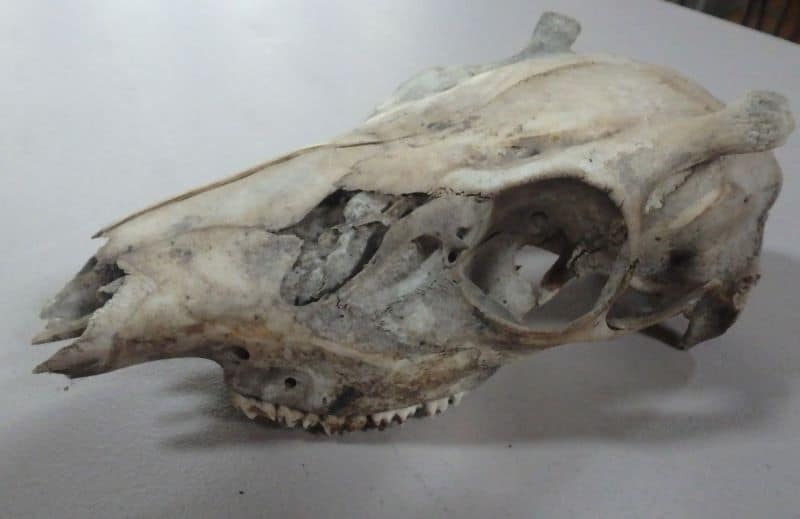
This photo of a button buck’s skull gives you a better feel for the pedicle as well as the “button antlers”. Remember that the skull will be covered with muscle and hide making the protrusion less visible.
The head shapes of doe fawns and buck fawns are definitely different come November. Seasoned deer observers and hunters can easily detect these differences, but it takes a bit of observation to reach that skill level. In good habitat it is conceivable that a buck fawn (or button buck) could be as large as a year and half old doe. This is especially true if the buck fawn was born in May by an experienced mother, and the year and a half doe was born in July the year before.
In Pennsylvania, you will hear hunters use the common term “doe tags”. Technically they are “Antlerless Licenses” and can be used to harvest any antlerless deer in that unit, whether it is a female or a button buck.
by Tim Burris, Preserve Manager.
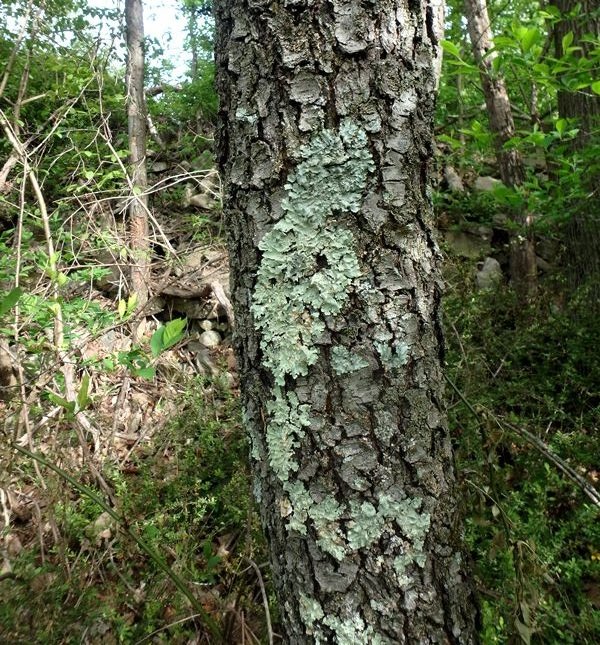
Photo by Tim Burris
So, one of the upsides of the pandemic has been better air quality. More empty roads and more empty work spaces meant less electricity generation and less emissions. We need to think about how to keep the economy running while doing without the emissions.
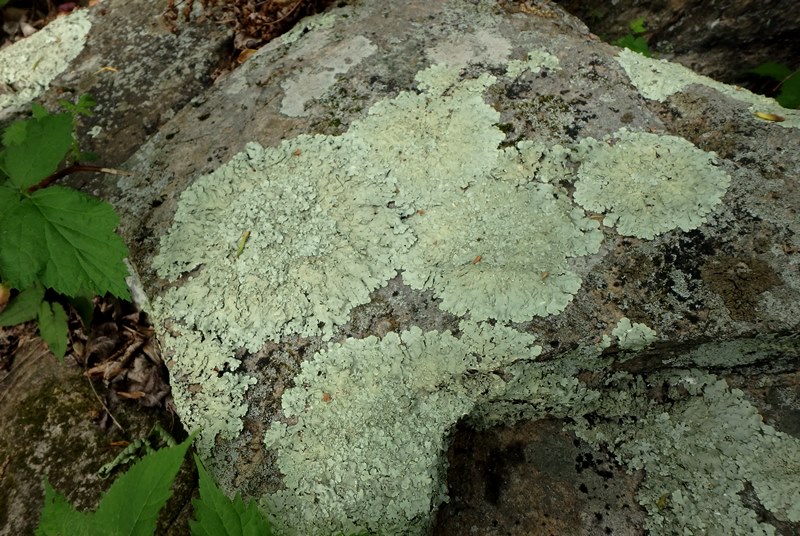
Photo by Tim Burris
One of the up-side-effects of the pandemic might be an increase in lichens: those wonderful symbiotic combinations of a fungi and an alga (plant). Only the maddest Mad Scientist would think about marrying two different life groups to form another distinct group of organisms. (A lichen is biologically weirder than the mythic Centaur.) And then you combine different species of fungi with different species of algae to form different lichens. Oh my!
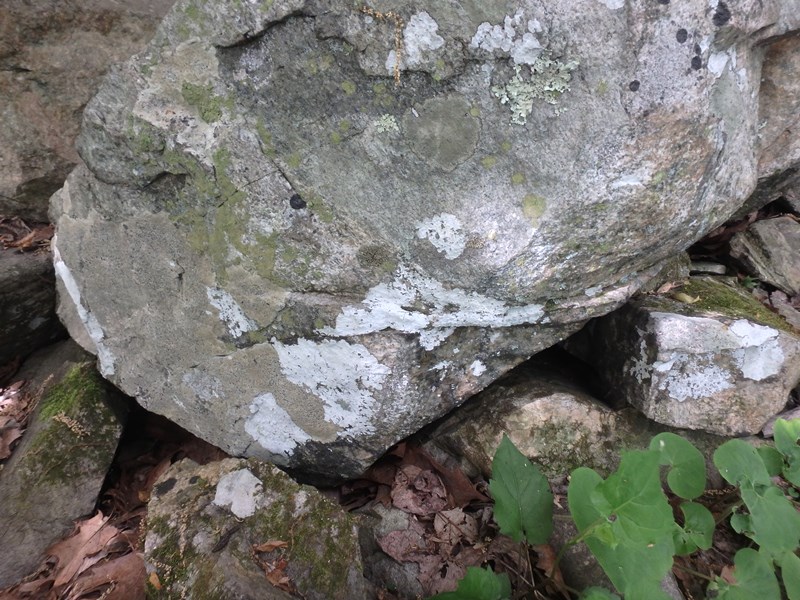
Photo by Tim Burris
Lichens rely on the air for many of their elements (algae – a plant – lack roots). So, lichens are often indicators of good air quality (and the lack of lichens can be an indicator of air pollution). On hunting trips in Canada (above the 55th Parallel) I was fascinated by the lichens. I saw orange, purple, and red lichens growing on rocks and the small Black Spruce trees. The variety of greens was astonishing. I could tell some of those lichens were ancient. Some lichens even had other lichens growing on them.
I mused about lichens a lot while pulling garlic mustard this spring. (Lichens were growing on the rocks where I was working, and pulling garlic mustard doesn’t tax many brain cells, leaving your brain a lot of energy for thinking.) If we could continue to improve air quality, could we see lichens growing in new, unexpected places? Would people be freaked out if they suddenly found lichens thriving on their houses, decks and trees? Lichens appear other-worldly, and I can imagine the calls from concerned homeowners who had never seen lichens before.
by Tim Burris, retired preserve manager
A lady on one of my walks asked me to do a Field Note on winter identification of poison ivy versus Virginia creeper. It was a great request and I recently came across a tuliptree with both species growing side by side. Both poison ivy and Virginia creeper are native plants in Pennsylvania. So, they have their place and purpose to the overall biodiversity of our forests.
Poison ivy (Toxicodendron radicans) is a hairy vine when it grows on trees. The vine on the left is characteristic of that growth. The hairs look like small roots. While vines are most common at Mariton Wildlife Sanctuary, there are places where it also grows as a low, creeping ground cover. (I will add that poison ivy can also be an upright stem growing up to three feet tall. I usually see the upright growth in clay soils that are often damp.) That is a good reason to stay on trails. Even in the winter oil from the stems can get on clothing or pet fur. When you touch those items, you could get the oil on your skin and have the allergic reaction. Poison ivy has the characteristic leaf with three leaflets, but sometimes those leaves aren’t evident on vines at eye level.
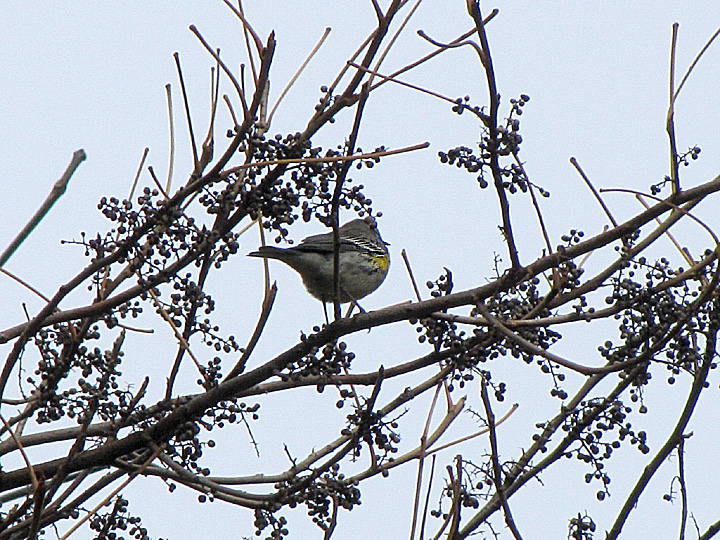
A Yellow-rumped Warbler in poison ivy berries. Photo by Carole Mebus.
I totally understand why someone who is extremely allergic to poison ivy wants to remove it from their property. I will, however, put in this plug for this native plant. It produces a lot of white berries that are important for wildlife, especially at the end of a long winter. I’ve watched everything from bluebirds to woodpeckers, and squirrels to deer eating the berries.

Virgina Creeper vine on the right. Photo by Tim Burris.
Virginia creeper (Parthenocisis quinquefolia) has brown “feelers” coming off of the vine. But on Virginia creeper, they tend to grow only along the side of the vine. These feelers help the vine attach to the tree and can be even more dense than this photo. Virginia creeper has five leaflets per leaf. It produces blue berries that are also an important wildlife food. The berries are small and can look like wild grapes, but don’t eat them. These are two native vines that can look similar until you study them more closely.
by Tim Burris, preserve manager.
I am returning to looking at tree bark.
Let’s look at two tree species that are probably the hardest in our area to tell apart by their bark. Tuliptree (Lireodendron tulipifera) is a common tree in Natural Lands’ forests. It is also known as Tulip Poplar and Yellow Poplar, but it is actually in the magnolia family. (I prefer to call it Tuliptree, because for me poplar will always refer to the aspens which are in the poplar family.)

Tuliptree bark
Tuliptree has a bark that I call “ridge and valleys with diamonds”. Imagine looking from space at one mountain chain after another with little diamond shaped valleys between the criss-crossed ridges.
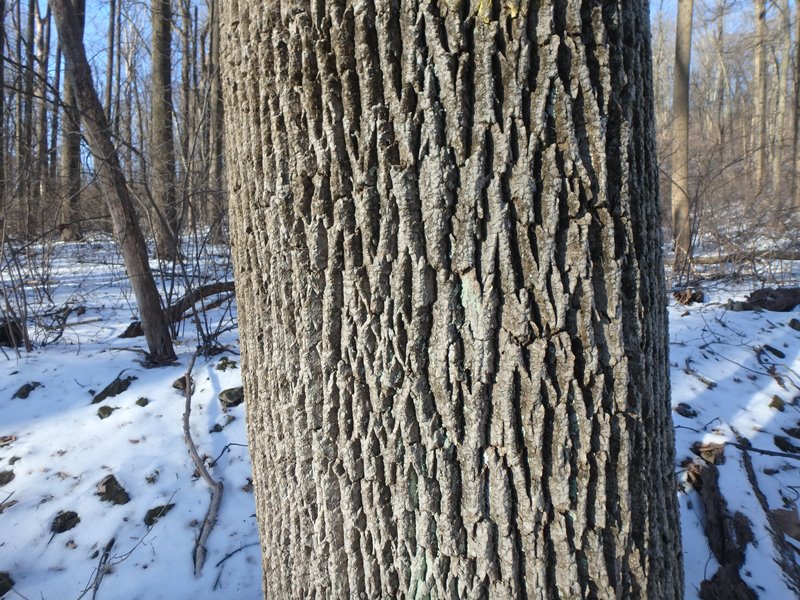
White Ash bark. There is a subtle difference.
White Ash (Fraxinus americana) has the same type of “ridge and valley with diamonds” bark. These two species are often found together, which makes it even more challenging to tell them apart. I need to look at the whole tree to be positive, but I can usually distinguish them at eye level (but then I’ve looked at tens of thousands of them over the last 40 years). When they are in leaf it is a very easy.
If you look at the White Ash above, you will see that it is a little grayer in tone. The Tuliptree is more brown. That is a pretty subtle difference. Another subtle difference is that the ridges are a little more peaked in the White Ash and a little flatter in the Tuliptree.
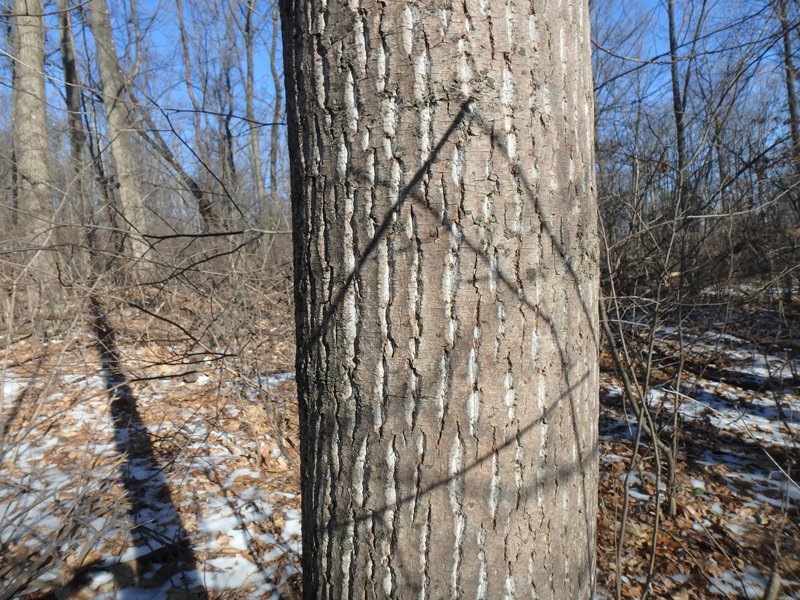
A younger Tuliptree.
Stepping back, I will look at the whole trunk of a leafless tree. Tuliptrees seem to be more cylindrical, while Ash trees start tapering inward from the ground. I know that is pretty subtle too.

An older Tuliptree. The ridges are getting flatter.
The real giveaway is the straightness of the trunk. Tuliptrees are different than a lot of species because they grow away from Earth’s gravity instead of toward the sun. Because of that growth characteristic they have straightness that you don’t find in other tree species. Even when they have been hit by lightning or had the terminal bud broken, you will see other branches respond by turning straight up away from Earth. White ashes grow straight also, but don’t seem to grow as straight as a Tuliptree. Finally, there is a very different pattern when you look at the branches against the sky.
Of course, right now most of our White Ash trees are dying because of a non-native insect called the Emerald Ash Borer. Dan and I have both written quite a bit about this insect and its affects in these Field Notes.
by Tim Burris, Preserve Manager. Photos by the “trail camera”.
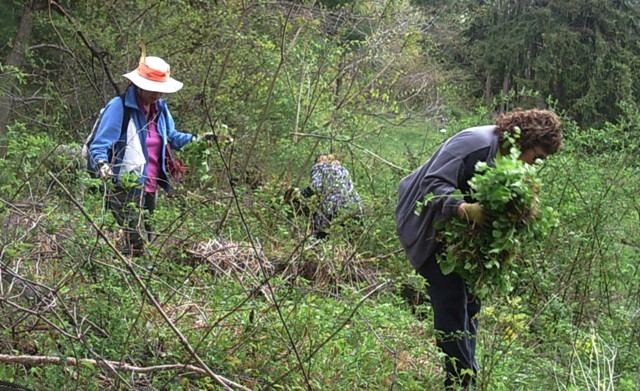
I cancelled the April Movie Night: Fox Tales as part of our Coronavirus response. Recently I checked the trail camera and had a lot of good photos of Red Foxes. So, I thought I would substitute the movie with a Field Note about Red Foxes using some trail camera photos. A lot of times the foxes are moving pretty quickly down the trail, so I have lots of blurred images.
While Red Foxes (Vulpes vulpes) are abundant, it is generally felt that they aren’t native to Pennsylvania. This belief is based on the lack of any Red Fox remains in Native American villages before European settlement. The middens of these villages provide a window into common species available to Native Americans, so the lack of Red Fox bones and skulls is a pretty good indicator that they didn’t live here (although they may have been in other parts of North America). It is believed that the Red Fox that we see now came from European stock brought over for hunting by English landowners.
Conversely, Gray Fox (Urocyon cinereoargenteus) bones are quite common in those Native American sites and the Gray Fox is considered Pennsylvania’s native fox. I’ll try not to digress too much about Gray Foxes, but when I first came to Mariton in 1992, Gray Foxes were very common, and I rarely saw Red Foxes. I haven’t seen a Gray Fox here in well over a decade. If you live in a rocky, forested area away from farmland, Gray Foxes may still be common.
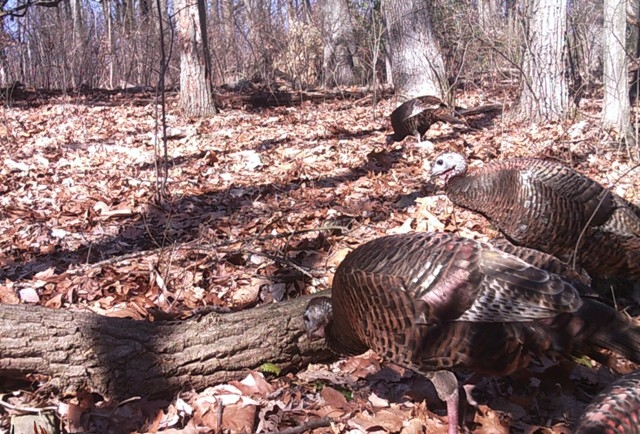
Red Foxes have many color variations, as you may see in these photos. I have seen Red Foxes that were colored almost completely gray. The two things to look for are a white-tipped tail and black stockings. Just a little white on the tail will distinguish a Red Fox from a Gray Fox. The black stockings can be harder to see in some color phases, but it is another indicator. Even the “red” can vary from orange to pink. They really are remarkable looking creatures.

Like most canids, Red Foxes are opportunistic feeders. They eat their share of rodents and small animals, as well as bird eggs, snakes and frogs. During the last 17 Year Cicada cycle in 2004, every fox scat that I found was filled with Cicada shells. They also like fruit. When the cherries are ripe I find scat with cherry pits. Foxes often mark their territory by defecating on a small rise, so you’ll often see scat on a rock that may be only slightly above the rest of the trail.
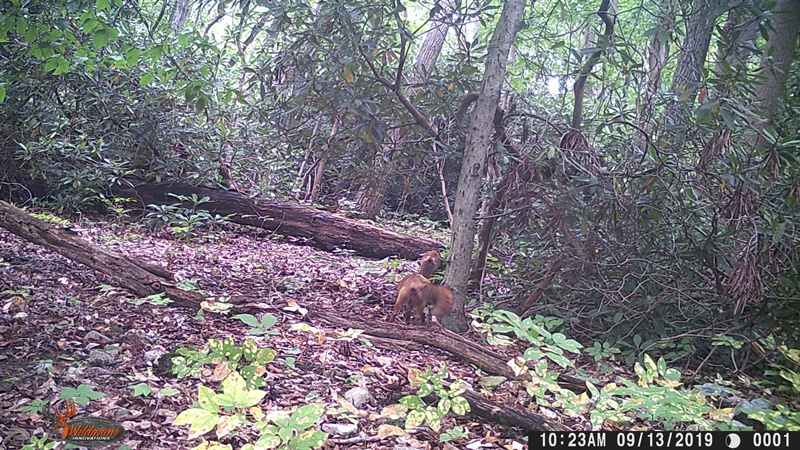
A rare shot: two foxes together.
Red Foxes mate for life. While the male doesn’t hang around the den when the kits are born, it isn’t an absentee father. The male brings food to the mother while she is occupied raising the young. When the young start exploring on their own, the male will also place food strategically to help the kits learn how to hunt. If the female dies, the male will move in to tend to the young. Once while sitting in a treestand, I watched a pair of Red Foxes with an interesting hunting strategy. First a fox moved along the hillside below me barking continuously. Even more strange, it made a lot noise by rustling leaves and breaking small branches. I watched as squirrels and birds fled up the hill in front of the noise. About ten minutes later another fox came by my treestand silently. It was about 20 yards up the hill from the first fox. I theorized that the second fox was taking advantage of any animals that were preoccupied with the noise of the first fox and might become easy prey.
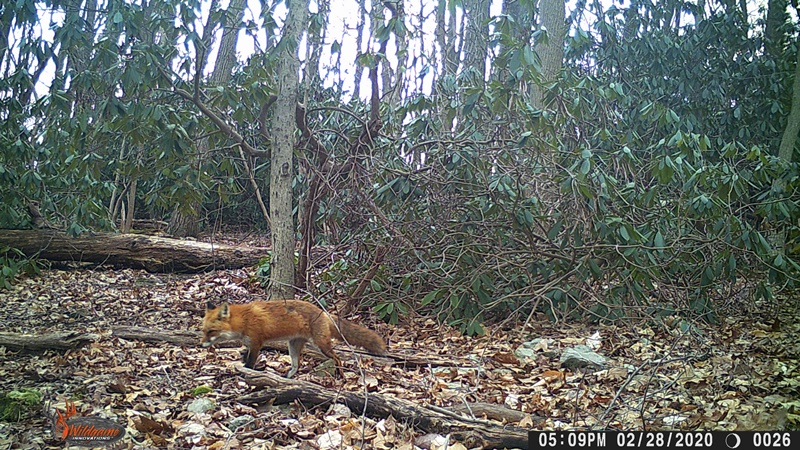
For many years, I watched Red Fox populations rise and fall. When the fox population got large, local foxes would often get mange or distemper and the population would crash. I haven’t seen that happening at Mariton of late. I think that coyotes (which prey on foxes) and cars have been regulating fox populations locally.
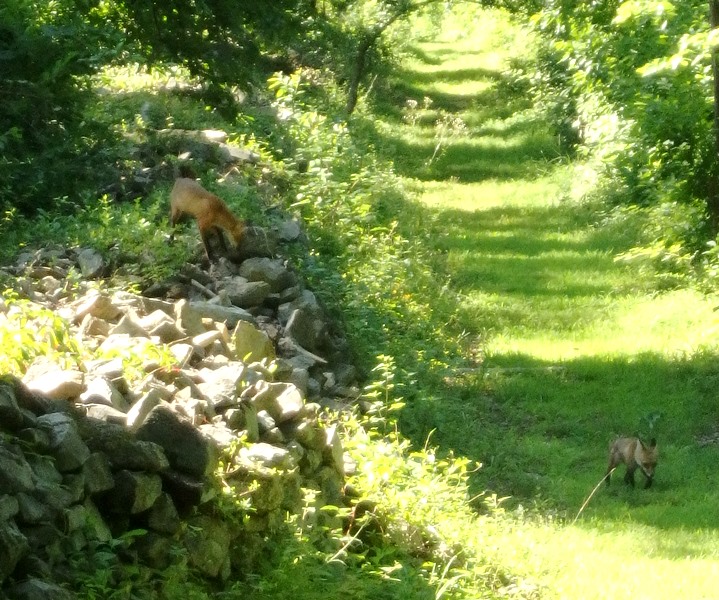
Fox kits on the Turnpike Trail. Photo by Tim Burris
Soon Red Fox kits will be venturing from their dens. In another month or so, their parents will be teaching them to hunt. Not everyone can stay still for long periods, but those that do often see more wildlife.
by Tim Burris, Preserve Manager.
The dominant oak species at Mariton are White Oak (Quercus alba), Red Oak (Q. rubra), Black Oak (Q. velutina), and Chestnut Oak (Q. prinus). I wrote about the Chestnut Oak bark in Chunky Bark.

White Oak
The texture of White Oak bark is what I would call lots of thin flaky scales. The scales don’t flake off as easily as they would seem. It is one of the lightest colored barks, which catches my eye in the forest. That along with the texture makes this tree very easy to identify.
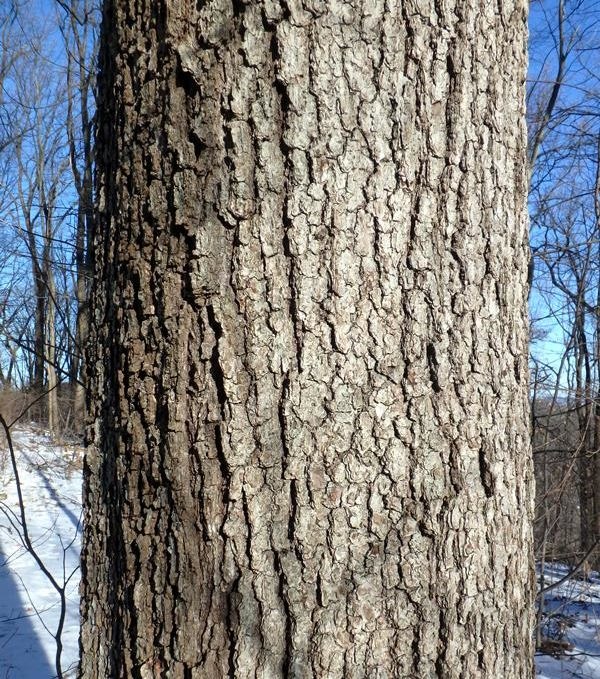
Black Oak
Black Oak is easy for me to recognize, but tough to describe and tough for people to learn. Contrary to the White Oak, Black Oak is one of the darkest trees in the forest. The bark is dark gray. It has scales, but they look thicker, rougher and tougher than the scales of White Oak.
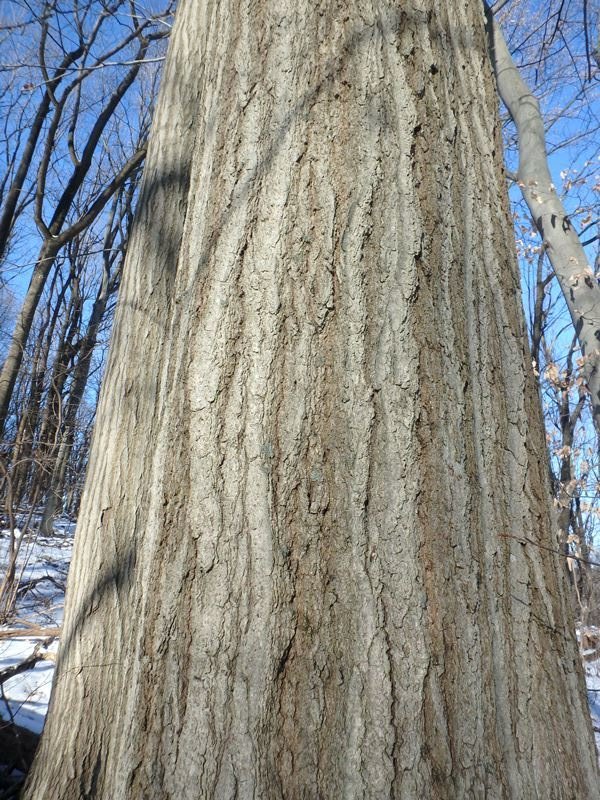
Red Oak
I absolutely love the look of Red Oak bark. Dr. Sakai said to think of someone’s ski tracks in fresh powder snow. I told my buddy, Jim (who is a skier), that and he laughed and saw it immediately. When we walk through the woods he loves to point out red oaks. Red Oak has smooth shiny plates, with rough fissures between the plates. The shiniest smoothest sections are on the younger sections of the tree. So, on old trees like the one in the picture, look high up on the tree.
The oaks become large trees. In the forest they have straight trunks. If they are planted in a yard or field, they often branch off ten to twenty feet up and then have wide spreading crowns.
by Tim Burris, preserve manager.
First, let me say that there is a lot of variation in tree bark. Of course, there is variation between species, but within species there is also variety. Bark usually changes as a tree grows in both age and size. I have also seen geographical variations of the same species. Birders have a term, G.I.S.S. (General Information, Shape, and Size), that they talk about when identifying birds that they might have only glimpsed. It takes account for lots of hours in the field, observing, and picking up on clues that exceed the basic information in a field guide. Likewise, as I continue this series on tree bark, the photos may or may not help you learn to identify trees. That’s okay. (I use other clues, like habitat, silhouettes, branches and other tips to confirm my ID of a tree.) I hope you enjoy the photos. I try to take these photos at eye level and of similar sized trees for comparison.
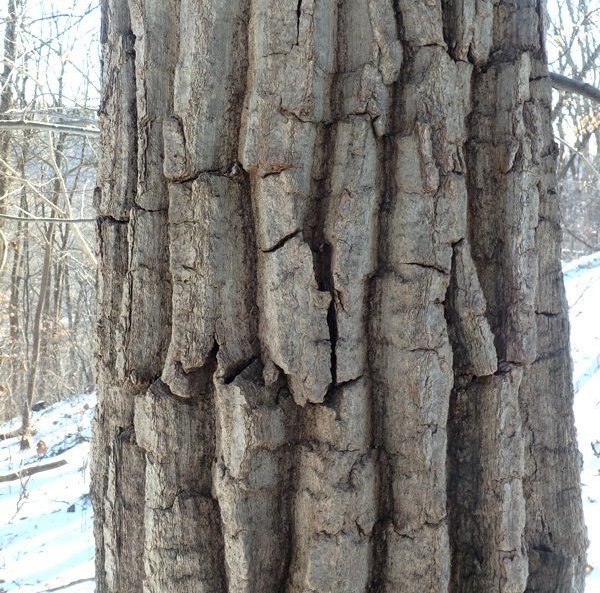
#1
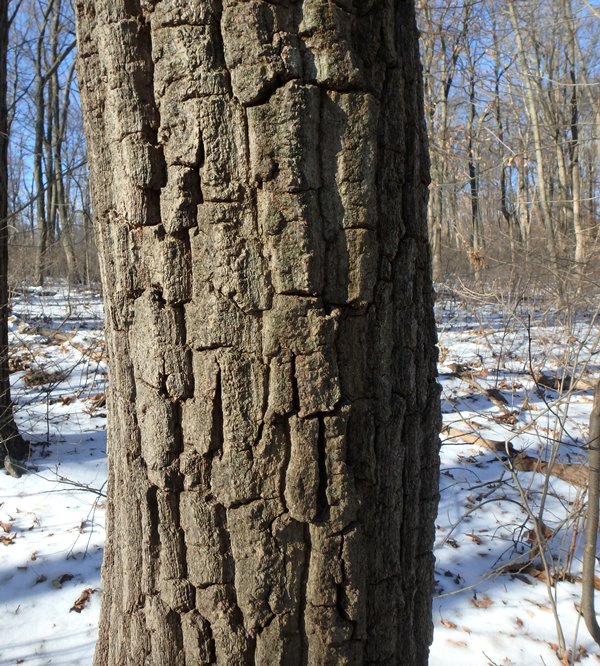
#2
Chunky Bark is one of the descriptors that my dendrology professor used. It is horribly ambiguous – until you start looking at trees. At Mariton, there are two chunky bark trees that can be confusing. Chestnut Oak (Quercus prinus) and Sassafras (Sassafras albidum) both have what I consider to be chunky bark. Sassafras has a little bit more of a pattern than the oak, but the hue of the bark is the tip off.
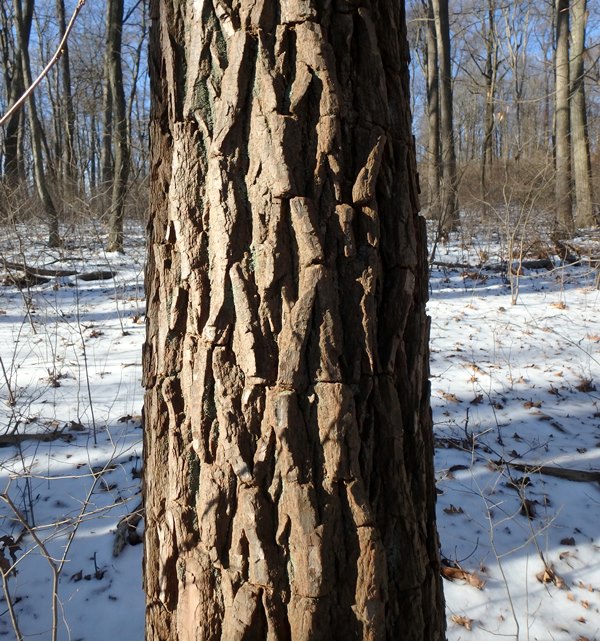
#3
#2 and #3 are trees of similar diameter, as are #1 and #4. You’ll notice that #3 and #4 have a little bit of orange, or reddish-brown highlights (Sassafras). #1 and #2 (Chestnut Oak) have a darker gray cast. Scroll back and forth between the photos and look for the orange versus gray, especially in the grooves of the bark.It is subtle in the photos, but more noticeable in the woods.#1 and #2 are Chestnut Oaks
#3 and #4 are Sassafras.
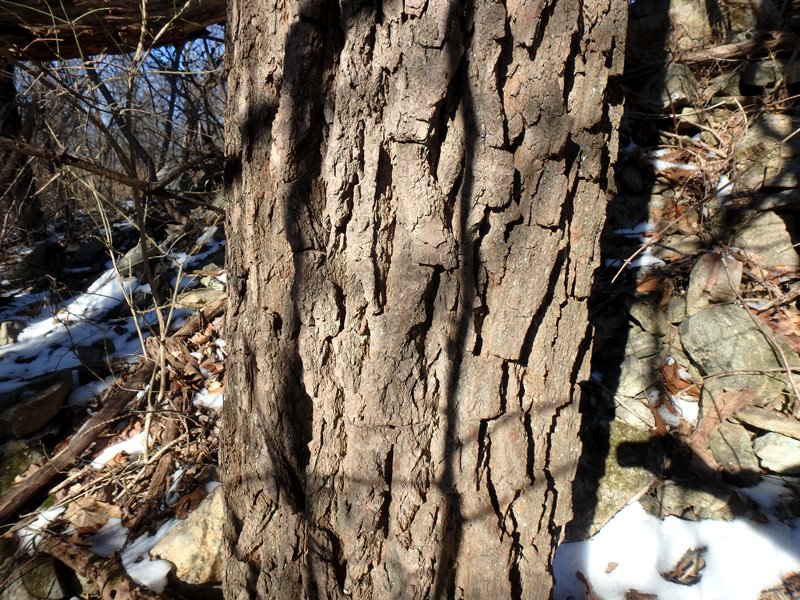
# 4 An older Sassafras tree.